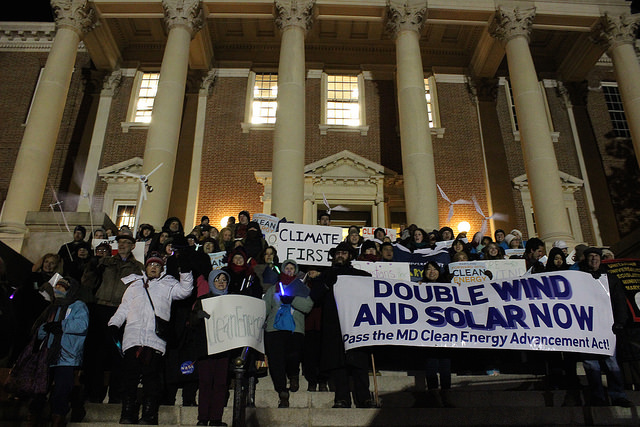Strong voter opposition aligns with Maryland Energy Administration, state attorney general, and Office of People’s Counsel
BALTIMORE—As Maryland utility regulators near a decision on the proposed merger between Exelon and Pepco Holdings, Inc, new poll
results show that a strong majority of Maryland voters—61 percent—oppose the deal.
The poll, conducted by the public interest research firm OpinionWorks, found that:
- Sixty-one percent of state voters oppose the merger, with only 22% expressing support and 17% unsure.
- Opposition is bipartisan, with 63% of Democrats and 60% of Republicans polled stating opposition.
- Notably, public opposition was strongest—with 73% opposed—in Baltimore City, where Exelon previously merged with BGE in 2012. City ratepayers have seen four rate hikes in three years since Exelon’s takeover.
“We now know that this merger is not only a bad deal for Marylanders, but a highly unpopular one as well,” said Mike Tidwell, director of the Chesapeake Climate Action Network. “Maryland voters do not want an Exelon monopoly in our state, and rightly so. This deal would harm ratepayers and harm our future ability to generate local, renewable energy. The Public Service Commission should reject it.”
The proposed merger, which would give Chicago-based Exelon control over 85 percent of Maryland ratepayers, is facing strong headwinds in the state. Last week, Maryland Attorney General Brian Frosh and the Maryland Energy Administration filed a brief with the Public Service Commission (PSC) affirming the state’s outright opposition.
“The merger enjoys no support from the state or numerous affected stakeholders,” wrote Frosh and the Maryland Energy Administration. “This is not surprising. … There is nothing in this nearly $7 billion transaction that is of tangible benefit to customers or Maryland’s economy. Worse, the transaction poses significant potential harms.”
The deal is also strongly opposed by the Maryland Office of People’s Counsel, as well as consumer and clean energy advocates. Opponents contest that Exelon is seeking to shore up its own shaky financial footing—as the nation’s largest owner of aging and increasingly expensive nuclear reactors—by taking over Pepco. The company also has a long track record of opposing clean energy policies at the federal and state levels, including legislation in Maryland to spur rooftop solar and local, distributed renewable energy.
The Maryland Public Service Commission (PSC) is charged with determining whether or not the proposed Exelon-Pepco merger is in the “public interest.” The PSC must rule on the merger by April 8, 2015.
The OpinionWorks poll, commissioned by the Chesapeake Climate Action Network, surveyed 594 randomly-selected Maryland registered voters between February 26, 2015 – March 8, 2015 and carries a margin of sampling error no greater than ±4.0%.
RESOURCES:
- View the memo on the Exelon-Pepco Maryland Voter Poll Results.
- View the brief submitted to the PSC by Attorney General Frosh and the Maryland Energy Administration.
- View the brief submitted to the PSC by the Sierra Club and the Chesapeake Climate Action Network.
CONTACT:
Mike Tidwell, 240-460-5838, mtidwell@chesapeakeclimate.org
Kelly Trout, 240-396-2022, kelly@chesapeakeclimate.org
###
The Chesapeake Climate Action Network is the biggest and oldest grassroots organization dedicated to fighting climate change in Maryland, Virginia and Washington, D.C. We’re building a powerful movement to shift our region away from climate-harming fossil fuels and to clean energy solutions.

